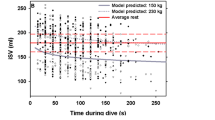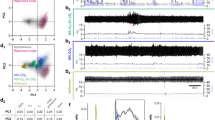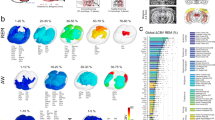Abstract
THE diving reflex has been studied extensively in aquatic organisms that breathe air and submerge to obtain food or to escape from predators such as ducks, seals and alligators1. This reflex seems to have two phases: an initial phase which may be mediated by the vagus and trigeminal nerves2, and a later one which follows prolonged holding of the breath during voluntary or forcible submersion3. The initial phase includes bradycardia1,4, apnoea (specifically, an interruption of respiration)1,4, peripheral vasoconstriction4,5 and cephalic vasodilation5. Gaunt and Gans6 have reported that bradycardia in Caiman crocolilius is minimal during spontaneous dives but great during the approach of an investigator or during handling. They suggest that early diving bradycardia is mainly “psychogenic” in origin and results from “threatening” stimuli. We have been studying (ref. 7 and unpublished results) the responses of the wholly aquatic salamander Necturus maculosus (mudpuppy) and have noted similarities to the early components of diving, specifically bradycardia and an interruption of respiration. (Necturus breathes through large external gills beating back and forth at 0.5–1.0 beats/s.) Insofar as it does not dive, we suggest here that these responses of Necturus are components of the orienting reflex8,9 rather than the initial diving reflex, and that both reflexes may reflect some common neural substrate involving adaptive responses to external stimulation.
This is a preview of subscription content, access via your institution
Access options
Subscribe to this journal
Receive 51 print issues and online access
$199.00 per year
only $3.90 per issue
Buy this article
- Purchase on Springer Link
- Instant access to full article PDF
Prices may be subject to local taxes which are calculated during checkout
Similar content being viewed by others
References
Andersen, H. T., Physiol. Rev., 46, 212 (1966).
Andersen, H. T., Acta Physiol. Scand., 58, 263 (1963).
Jones, D. R., and Shelton, G., J. Exp. Biol., 41, 417 (1964).
Fergl, E., and Folkow, B., Acta Physiol. Scand., 37, 99 (1963).
Johansen, K., Acta Physiol. Scand., 62, 1 (1964).
Gaunt, A., and Gans, C., Nature, 223, 207 (1969).
Goodman, D. A., thesis, University of California, Irvine (1969).
Pavlov, I., Conditioned Reflexes (Oxford University Press, New York, 1927).
Sokolov, E., Perception and the Conditioned Reflex (Macmillan, New York, 1963).
Weinberger, N. M., and Goodman, D. A., Behav. Res. Meth. and Instr., 1, 192 (1969).
Thompson, R. F., and Spencer, W. A., Psychol. Rev., 173, 16 (1966).
Graham, F., and Clifton, R., Psychol. Bull., 65, 306 (1966).
Davis, R. C., Buchwald, A. M., and Frankmann, R., Psychol. Mon., 405 (1955).
Lynn, R., Attention, Arousal and the Orienting Reaction (Pergamon, New York, 1966).
Belkin, D. A., Amer. Zool., 8, 775 (1968).
Ursin, H., Wester, K., and Ursin, R., Electroenceph. Clin. Neurophysiol., 23, 41 (1967).
Jasper, H. H., in Reticular Formation of the Brain (edit. by Jasper, H. H., et al.), 319 (Churchill, London, 1958).
Reiz, D., and McHugh, P., Amer. J. Physiol., 214, 601 (1968).
Ursin, H., and Kaada, B. R., Exp. Neurol., 2, 109 (1960).
Folkow, B., Buxe, K., and Sonnenschein, R., Acta Physiol. Scand., 67, 327 (1966).
Folkow, B., Nilsson, N., and Yonce, L., Acta Physiol. Scand., 70, 347 (1967).
Andersen, H. T., Acta Physiol. Scand., 53, 23 (1961).
Lund, G. F., and Dingle, H. J., J. Exp. Biol., 48, 265 (1968).
Author information
Authors and Affiliations
Rights and permissions
About this article
Cite this article
GOODMAN, D., WEINBERGER, N. Possible Relationships between Orienting and Diving Reflexes. Nature 225, 1153–1155 (1970). https://doi.org/10.1038/2251153b0
Received:
Issue Date:
DOI: https://doi.org/10.1038/2251153b0
This article is cited by
-
Typical vasovagal syncope as a “defense mechanism” for the heart by contrasting sympathetic overactivity
Clinical Autonomic Research (2017)
-
The origin of vasovagal syncope: to protect the heart or to escape predation?
Clinical Autonomic Research (2008)
Comments
By submitting a comment you agree to abide by our Terms and Community Guidelines. If you find something abusive or that does not comply with our terms or guidelines please flag it as inappropriate.



